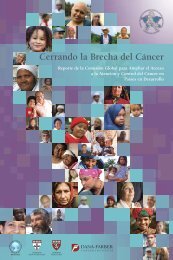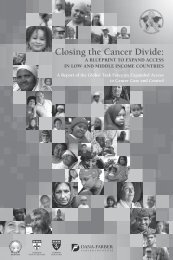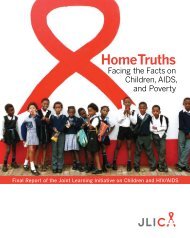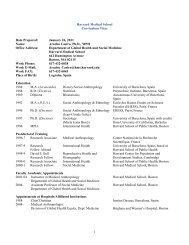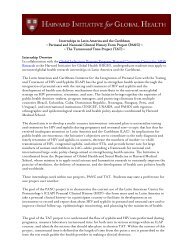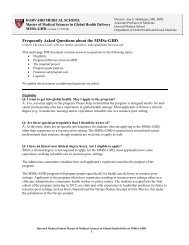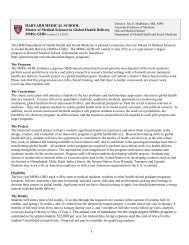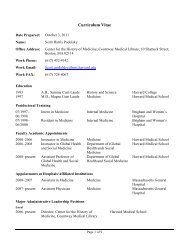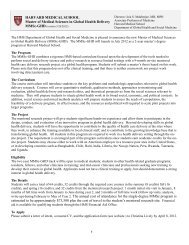Haiti Case Study - The Department of Global Health and Social ...
Haiti Case Study - The Department of Global Health and Social ...
Haiti Case Study - The Department of Global Health and Social ...
Create successful ePaper yourself
Turn your PDF publications into a flip-book with our unique Google optimized e-Paper software.
CHALLENGE TO THE HEALTH SYSTEM<br />
Annex C<br />
NARRATIVE:<br />
CHOLERA – THE SECOND SHOCK<br />
1. Ten months after the devastation wreaked by the earthquake, a second dreadful threat<br />
to the population materialized: cholera. In <strong>Haiti</strong>, as <strong>of</strong> January 2012, over 500,000 people<br />
have become infected <strong>and</strong> more than 7,000 have died from cholera. 148 <strong>The</strong> sudden lethal<br />
outbreak was incomprehensible to the <strong>Haiti</strong>an population. One blogger described the<br />
reaction in her neighbourhood to the epidemic: "terrified residents saw stricken young<br />
neighbors die within hours <strong>of</strong> developing symptoms. <strong>The</strong> speed <strong>and</strong> violence <strong>of</strong> the illness<br />
convinced residents the water must have been deliberately poisoned with a chemical, not a<br />
germ or bacteria because they had drunk the same dirty water their whole lives <strong>and</strong> had<br />
never fallen ill before." 149<br />
2. <strong>The</strong>re was great concern over waterborne diseases in the aftermath <strong>of</strong> the earthquake.<br />
<strong>The</strong> population had limited access to safe water because <strong>of</strong> underlying poor levels <strong>of</strong><br />
sanitation compounded by the destruction <strong>of</strong> water system infrastructure during the<br />
earthquake. In March 2010, the Center for Disease Control (CDC) estimated the chance <strong>of</strong><br />
an outbreak <strong>of</strong> waterborne diseases as high, although it determined that an outbreak <strong>of</strong><br />
cholera was unlikely because cholera was historically not endemic to <strong>Haiti</strong>. 150 Nonetheless,<br />
ten months after the earthquake, in late October 2010, <strong>Haiti</strong> saw its first <strong>of</strong>ficially reported<br />
cholera case <strong>and</strong> the epidemic soon spread to all <strong>Haiti</strong>an <strong>Department</strong>s. 151<br />
3. <strong>The</strong> cholera epidemic broke out first along Artibonite River. <strong>The</strong> proximity <strong>of</strong> one UN<br />
peacekeeper compound to the Artibonite River <strong>and</strong> the identification <strong>of</strong> an Asian string <strong>of</strong><br />
cholera indicated that a UN battalion from Asia could have brought the bacteria into the<br />
country. 152 After the association <strong>of</strong> cholera fatalities with the UN mission, anger, frustration<br />
<strong>and</strong> unrest among the <strong>Haiti</strong>an population broke out very quickly. 153 A deputy mayor told the<br />
New York Times <strong>of</strong> his anger towards MINUSTAH <strong>and</strong> that he had even considered killing<br />
Nepalese UN soldiers. He added that, “If they hadn’t left, we would have burned it [the<br />
Nepalese UN Camp] down.” 154<br />
4. Elections held at the end <strong>of</strong> November 2010 contributed to an increase in violence on<br />
the streets 155 <strong>and</strong> in the weeks following the first cases <strong>of</strong> cholera, protests <strong>and</strong> riots erupted<br />
in the affected areas <strong>and</strong> soon spread across the whole country 156 . Outbreaks <strong>of</strong> violence<br />
requiring MINUSTAH intervention were not only directed at MINUSTAH but also, as a result<br />
<strong>of</strong> fear among the population, directed at cholera treatment facilities provided by NGOs. For<br />
example, terrified residents violently protested the opening <strong>of</strong> a 400-bed cholera clinic nearby<br />
for fear that the clinic would bring more cholera into the region. MINUSTAH had to respond<br />
to these protests <strong>and</strong> the clinic was not opened. 157 Another NGO clinic required protection<br />
because people’s frustration with the slow cholera response turned into violent riots. 158<br />
5. <strong>The</strong> increased violence <strong>and</strong> instability made it more difficult to circulate response<br />
resources which in turn hampered the fight against the epidemic. 159 Besides the increase in<br />
instability, the cholera outbreak also impacted food security. According to a FAO report,<br />
many farmers feared that the water irrigating the rice fields could have been infected. 160 <strong>The</strong><br />
security ramifications <strong>of</strong> the epidemic led <strong>Haiti</strong>an health authorities to declare the epidemic "a<br />
national security problem”. 161<br />
6. <strong>The</strong> impact on the health system has been immense. Cholera patients have overrun<br />
clinics <strong>and</strong> hospitals, with many hospitals seeing hundreds <strong>of</strong> patients per day. 162 <strong>The</strong><br />
consumption <strong>of</strong> health supplies, provider time, <strong>and</strong> money necessary to treat these patients<br />
has distracted <strong>and</strong> continues to distract from efforts to strengthen <strong>Haiti</strong>'s health system. Fear<br />
C-1



